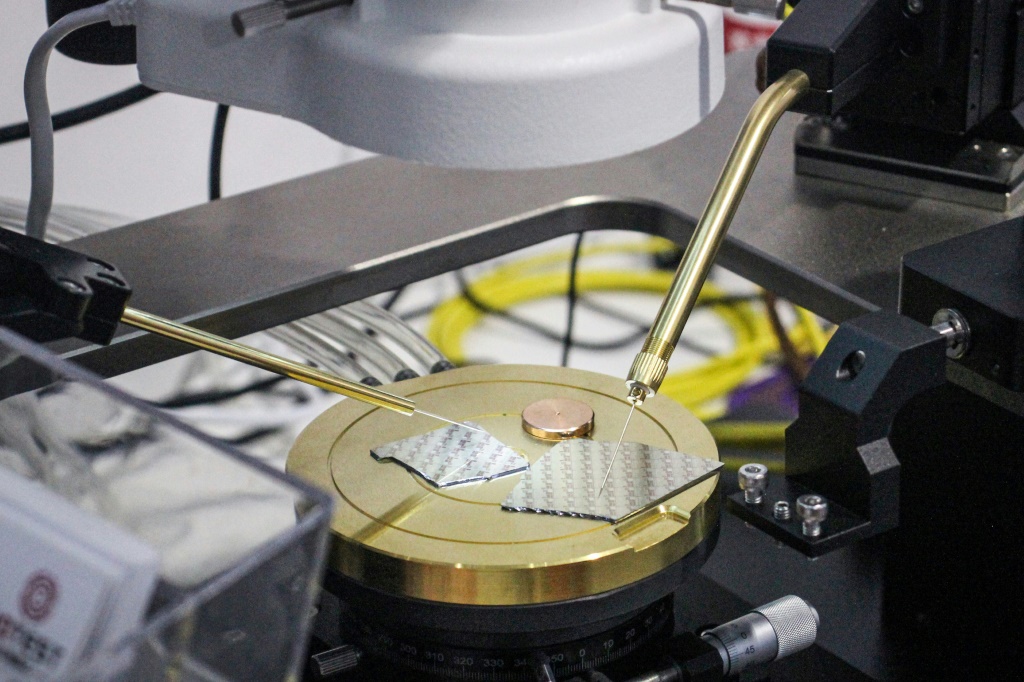Semiconductors on display at the SEMICON China semiconductor exhibition on March 22, 2024 in Shanghai
“Support Chinese chips”: that was the slogan of a recent semiconductor show in Shanghai, reflecting the sector’s optimism despite the barrage of American sanctions in recent years.
The stands at the Semicon trade fair, held last week in the eastern Chinese megacity, were full of visitors curious to take a closer look at these microchips.
Highly strategic, they are essential to the production of a multitude of electronic devices, from coffee machines to electric cars and smartphones, and are also present in weapons.
And for several years, they have been at the heart of a geopolitical standoff, with the United States and several European countries having decided to block exports of advanced technology in semiconductors to China, for fear of its use for military purposes.
“The more the United States imposes restrictions on us, the faster some of our national companies will develop,” assures AFP a professional in the sector, Mr. Wang.
Same opinion for Vicky Zheng, representative of a chip assembly company in Qingdao (east): according to her, the restrictions will force China to “develop further to catch up, or even to replace products, in order to have more and better solutions.
– Local chip –
Mr. Huang, an exhibitor whose semiconductor testing company, King Long Technology, is located in Suzhou, near Shanghai, also expresses his confidence.
“In an environment under such pressure, China is making very rapid progress in increasing its technology and production capabilities, as well as in the training of technical personnel,” he assures.
Proof of this progress: in September, the Chinese giant Huawei unveiled its new Mate 60 Pro phone, equipped with a Kirin 9000s chip.
The chip is intended to be a locally manufactured replacement for the Kirin 9000 produced by the Taiwanese champion of the sector, TSMC. Huawei no longer has the right to obtain supplies from TSMC due to American sanctions.
But the exact provenance of this chip is now in question.
Last Thursday, a US official said that Chinese semiconductor heavyweight SMIC may have violated US law by supplying Huawei despite sanctions. Smic shares then fell on the stock market.
Mr. Huang, of the King Long group, acknowledges that foreign restrictions will “still have an impact” on the sector, especially in the short term.
Most Chinese chip manufacturers announced losses last year. Loongson Technology, which designs it, suffered a net loss of 329 million yuan (42 million euros), compared to a profit of 5.2 million yuan a year earlier.
Loongson, blacklisted in 2023 by the US Department of Commerce and therefore deprived of any access to American technologies, admitted last month that its research and development costs had increased by 36%.
– “At least a decade” –
For Scotten W. Jones, of the specialist site TechInsights, the semiconductor manufacturing technology currently available in China is “far behind the best models from ASML”, the Dutch giant in the sector.
“If China is willing to invest enough, it will probably be able to catch up with the rest of the world, but I think we will have to wait at least a decade,” said the expert.
Beijing indeed seems ready to invest: according to the Bloomberg agency, China is in the process of raising more than $27 billion for a fund dedicated to the chip industry.
Hence the optimism observed at the Semicon show in Shanghai: according to Robyn Klingler-Vidra, an innovation specialist at King’s College in London, it is “justified” by the pace at which Chinese companies are catching up. .
She cites Huawei’s new chip made by Smic, emphasizing that the two companies are “studying” even more sophisticated chips.
“This runs counter to ideas that, despite significant government investment, China is only competitive in sectors that are already mature,” observes Ms. Klingler-Vidra.
LNT with Afp
#Semiconductors #sanctions #Chinese #sector #maintains #morale
– 2024-04-09 06:14:29


